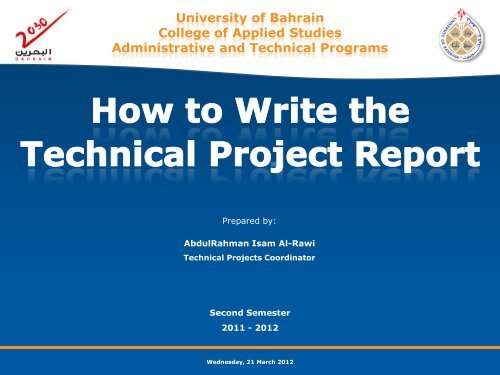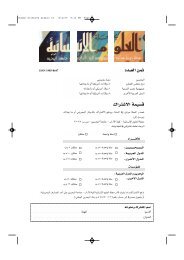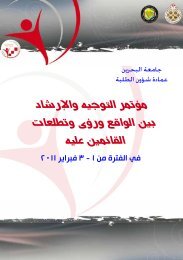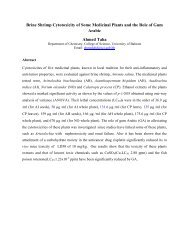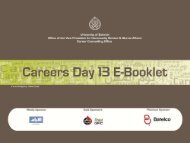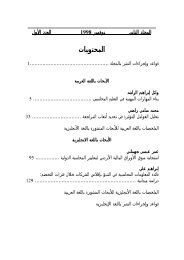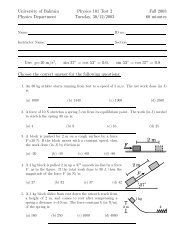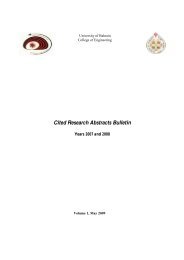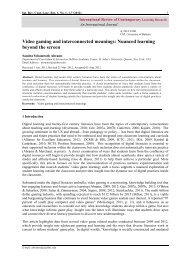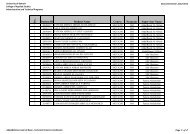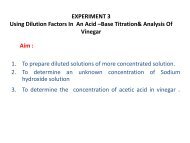Contents of the Project's Report
Contents of the Project's Report
Contents of the Project's Report
You also want an ePaper? Increase the reach of your titles
YUMPU automatically turns print PDFs into web optimized ePapers that Google loves.
University <strong>of</strong> Bahrain<br />
College <strong>of</strong> Applied Studies<br />
Administrative and Technical Programs<br />
Prepared by:<br />
AbdulRahman Isam Al-Rawi<br />
Technical Projects Coordinator<br />
Second Semester<br />
2011 - 2012<br />
Wednesday, 21 March 2012
ALWAYS<br />
Trust Yourself<br />
كن واثقا<br />
بنفسك دائما
Important Notes<br />
The Technical Project mark distribution is as follows:<br />
‣ Practical Part: 50%.<br />
‣ Project’s <strong>Report</strong> 30%.<br />
‣ Project’s Presentation 20%.<br />
How to Write <strong>the</strong> Technical Project <strong>Report</strong><br />
21 March 2012
Important Notes<br />
Your <strong>Report</strong> will be evaluated based on <strong>the</strong> following factors<br />
‣ Completeness 10%.<br />
‣ Organization and Formatting 10%.<br />
‣ Citation and References 10%.<br />
How to Write <strong>the</strong> Technical Project <strong>Report</strong><br />
21 March 2012
Important Notes<br />
‣ Start writing your report early.<br />
‣ Plan for your report (project<br />
documentation) as you plan for <strong>the</strong><br />
practical part <strong>of</strong> <strong>the</strong> project.<br />
‣ Your report should not exceed<br />
15 pages.<br />
How to Write <strong>the</strong> Technical Project <strong>Report</strong><br />
21 March 2012
Important Notes<br />
‣ Consult your supervisor before and<br />
after writing each part <strong>of</strong> <strong>the</strong> report.<br />
‣ Give your supervisor enough time to<br />
read and revise it.<br />
‣ The submitted report should be<br />
bounded as spiral or as a s<strong>of</strong>t/hard<br />
cover.<br />
‣ <strong>Report</strong> bounded as stapled pages is<br />
not accepted.<br />
How to Write <strong>the</strong> Technical Project <strong>Report</strong><br />
21 March 2012
COMPLETE<br />
Your Work to<br />
<strong>the</strong> End<br />
أنجز عمهك<br />
حتى اننهاية
<strong>Report</strong> Submission deadline<br />
‣ Sunday, May 27, 2012 is <strong>the</strong> deadline for submitting your report.<br />
You will be penalized by (-1) mark for each working day <strong>of</strong> delay.<br />
‣ Submit FOUR copies <strong>of</strong> <strong>the</strong> project’s report to your supervisor.<br />
How to Write <strong>the</strong> Technical Project <strong>Report</strong><br />
21 March 2012
<strong>Report</strong> Page Formatting<br />
‣ Use regular white A4 paper.<br />
‣ All pages are single sided.<br />
‣ Paper margins should be about:<br />
• Top: 2.54 cm<br />
• Bottom: 2.54 cm<br />
• Left: 3.5 cm<br />
• Right: 2.54 cm<br />
‣ You can also use <strong>the</strong> default MS word<br />
margins.<br />
How to Write <strong>the</strong> Technical Project <strong>Report</strong><br />
21 March 2012
<strong>Report</strong> Page Numbering<br />
‣ Title page has NO number.<br />
‣ Numeric page numbering begins with <strong>the</strong> first page <strong>of</strong> Chapter 1.<br />
How to Write <strong>the</strong> Technical Project <strong>Report</strong><br />
21 March 2012
Paragraph Spacing & Justification<br />
‣ Justify <strong>the</strong> paragraph.<br />
‣ Text is 1.5-spaced, except for long<br />
quotations.<br />
‣ Skip a line between paragraphs.<br />
How to Write <strong>the</strong> Technical Project <strong>Report</strong><br />
21 March 2012
Font Type and Formatting<br />
‣ Use readable fonts.<br />
‣ It is preferable to use Serif fonts for<br />
body text.<br />
‣ Use font formats (bold, italic, or<br />
underline) only for a specific purpose.<br />
Sans Serif<br />
Sans Serif<br />
Sans Serif<br />
Serif<br />
Serif<br />
Serif<br />
How to Write <strong>the</strong> Technical Project <strong>Report</strong><br />
21 March 2012
Font Size<br />
‣ Font size for <strong>the</strong> body text should be<br />
12-14, and 16-18 for <strong>the</strong> headings.<br />
‣ Headings MUST be larger than subheading<br />
and body text.<br />
‣ Sub-headings MUST be larger than<br />
body text.<br />
Heading (title)<br />
Sub-heading (sub-title)<br />
Body text must be smaller than<br />
sub-headings and heading. Serif<br />
font is preferable for body text,<br />
while sans-serif is preferable for<br />
titles and sub-titles.<br />
How to Write <strong>the</strong> Technical Project <strong>Report</strong><br />
21 March 2012
ال تستسهم DON’T<br />
نهفشم أبدا Give in to Failure
<strong>Contents</strong> <strong>of</strong> <strong>the</strong> Project’s <strong>Report</strong><br />
1. Title page.<br />
2. Approved project proposal form.<br />
3. Acknowledgments.<br />
4. Abstract.<br />
5. Table <strong>of</strong> <strong>Contents</strong>.<br />
6. Chapter One: Introduction.<br />
7. Chapter Two: Theory Related to <strong>the</strong> Project.<br />
8. Chapter Three: Description <strong>of</strong> <strong>the</strong> Project.<br />
9. Chapter Four: Results and Analysis (optional).<br />
Except for Commercial Studies which is REQUIRED<br />
10. Chapter Five: Conclusion and Recommendation<br />
11. References.<br />
12. Appendices (optional).<br />
How to Write <strong>the</strong> Technical Project <strong>Report</strong><br />
21 March 2012
Title Page<br />
‣ All text on <strong>the</strong> title page is centered<br />
vertically and horizontally.<br />
‣ The title page has NO number.<br />
‣ The title page should include:<br />
1. University and College names.<br />
2. Project’s title.<br />
3. Student(s) name(s) and ID(s).<br />
4. Supervisor name.<br />
5. Date <strong>of</strong> submission.<br />
How to Write <strong>the</strong> Technical Project <strong>Report</strong><br />
21 March 2012
Approved Project Proposal Form<br />
‣ The attached proposal form must be<br />
signed by <strong>the</strong> students and <strong>the</strong>ir<br />
supervisor.<br />
How to Write <strong>the</strong> Technical Project <strong>Report</strong><br />
21 March 2012
Acknowledgments<br />
‣ Thank your supervisor and o<strong>the</strong>r<br />
individuals who have provided any<br />
assistance.<br />
How to Write <strong>the</strong> Technical Project <strong>Report</strong><br />
21 March 2012
Abstract<br />
‣ Write your abstract after <strong>the</strong> rest <strong>of</strong> <strong>the</strong> report is completed.<br />
‣ It tells <strong>the</strong> reader WHAT you did, WHY you did it, HOW you did it,<br />
WHAT you found, and WHAT it means.<br />
‣ Write only what is essential briefly, using no more words than<br />
necessary to convey meaning.<br />
How to Write <strong>the</strong> Technical Project <strong>Report</strong><br />
21 March 2012
Table <strong>of</strong> <strong>Contents</strong><br />
‣ It lists <strong>the</strong> main topics and subtopics <strong>of</strong><br />
your report as well as <strong>the</strong><br />
corresponding page numbers for each.<br />
‣ Items in <strong>the</strong> table <strong>of</strong> contents should<br />
be ordered by page number.<br />
‣ It is <strong>the</strong> last page that you will do.<br />
How to Write <strong>the</strong> Technical Project <strong>Report</strong><br />
21 March 2012
COMPLETE<br />
One Task<br />
at a Time<br />
قم بعمم واحد<br />
في وقت واحد
Chapter 1:<br />
Introduction<br />
‣ Start with a paragraph that introduces your topic to <strong>the</strong> reader.<br />
‣ Provide a clear summary <strong>of</strong> <strong>the</strong> project's background, relevance and<br />
main contributions.<br />
‣ Concentrate on <strong>the</strong> big issues, and avoid <strong>the</strong> temptation to list low<br />
level objectives.<br />
How to Write <strong>the</strong> Technical Project <strong>Report</strong><br />
21 March 2012
Chapter 2<br />
Theory Related to <strong>the</strong> Project<br />
‣ Write any related existing published<br />
work (research papers, articles, text<br />
books, technical manuals, or even<br />
existing s<strong>of</strong>tware or hardware) which<br />
you read at <strong>the</strong> start <strong>of</strong> <strong>the</strong> project<br />
when your approach and methods were<br />
being considered.<br />
How to Write <strong>the</strong> Technical Project <strong>Report</strong><br />
21 March 2012
Chapter 2<br />
Theory Related to <strong>the</strong> Project<br />
‣ You must acknowledge <strong>the</strong> sources <strong>of</strong><br />
your inspiration.<br />
‣ DO NOT Copy and Paste without<br />
citation!<br />
‣ Provide at least three different<br />
references from various sources.<br />
How to Write <strong>the</strong> Technical Project <strong>Report</strong><br />
21 March 2012
Chapter 3<br />
Description <strong>of</strong> <strong>the</strong> Project<br />
‣ Identify your project and explain its significance.<br />
‣ Discuss in detail <strong>the</strong> methods used to develop your project.<br />
How to Write <strong>the</strong> Technical Project <strong>Report</strong><br />
21 March 2012
Chapter 4<br />
Results and Analysis<br />
‣ Answer <strong>the</strong> questions “What did you find?” and “What do <strong>the</strong>se<br />
findings mean?”.You should evaluate <strong>the</strong> strengths and weaknesses<br />
<strong>of</strong> what you have done.<br />
How to Write <strong>the</strong> Technical Project <strong>Report</strong><br />
21 March 2012
Chapter 4<br />
Results and Analysis<br />
‣ You should evaluate what you have done both in absolute terms and<br />
in comparison with existing techniques, s<strong>of</strong>tware, hardware, etc.<br />
How to Write <strong>the</strong> Technical Project <strong>Report</strong><br />
21 March 2012
Chapter 4<br />
Results and Analysis<br />
‣ Avoid statements like "The project has been a complete success and<br />
we have solved all <strong>the</strong> problems associated with it”, It is important<br />
to understand that <strong>the</strong>re is no such thing as a perfect project.<br />
How to Write <strong>the</strong> Technical Project <strong>Report</strong><br />
21 March 2012
Chapter 5<br />
Conclusions & Recommendations<br />
‣ The project's conclusions should LIST <strong>the</strong> findings which have been<br />
learnt as a result <strong>of</strong> your work.<br />
How to Write <strong>the</strong> Technical Project <strong>Report</strong><br />
21 March 2012
Chapter 5<br />
Conclusions & Recommendations<br />
‣ LIST recommendations based on your findings.<br />
‣ Avoid listing recommendations based on your own beliefs that are<br />
not specifically supported by your findings.<br />
How to Write <strong>the</strong> Technical Project <strong>Report</strong><br />
21 March 2012
References<br />
‣ Consists <strong>of</strong> a list <strong>of</strong> all <strong>the</strong> books, articles, manuals, websites, etc.<br />
used in <strong>the</strong> project and referred to in <strong>the</strong> report.<br />
‣ You should provide enough information to allow <strong>the</strong> reader to find<br />
<strong>the</strong> source.<br />
How to Write <strong>the</strong> Technical Project <strong>Report</strong><br />
21 March 2012
How to Cite your References<br />
‣ If you quote or make use <strong>of</strong> ano<strong>the</strong>r writer's work, you must ensure<br />
that it is properly referenced.<br />
‣ The method used for making citations and organizing references in<br />
your report is <strong>the</strong> Numeric system, you should stick to it and use it<br />
consistently.<br />
How to Write <strong>the</strong> Technical Project <strong>Report</strong><br />
21 March 2012
How to Cite your References<br />
“Numeric System”<br />
‣ References (publications, articles, books, etc) cited or referred to in<br />
<strong>the</strong> text are consecutively numbered.<br />
‣ The number should be written between square brackets at <strong>the</strong> end<br />
<strong>of</strong> <strong>the</strong> sentence(s) or paragraph(s).<br />
How to Write <strong>the</strong> Technical Project <strong>Report</strong><br />
21 March 2012
How to Cite your References<br />
“Numeric System”<br />
‣ References are arranged in numerical order at <strong>the</strong> references<br />
section <strong>of</strong> your report.<br />
References<br />
[1] Li. Y. Wei and Marc L., "Fast Texture Syn<strong>the</strong>sis Using Tree-Structured Vector<br />
Quantization", Stanford University, 2000.<br />
[2] "Digital Image Interpolation", Cambridge in Color, a part <strong>of</strong> Cambridge University<br />
Photographics Society. Available at:<br />
[URL: http://www.cambridgeincolour.com/tutorials/image- interpolation.htm]<br />
[3] Rafael C. Gonzalez and Richard E. Woods, "Digital Image Processing", Wesley<br />
Publishing, 2001<br />
How to Write <strong>the</strong> Technical Project <strong>Report</strong><br />
21 March 2012
For each problem<br />
Search for SOLUTIONS<br />
Ra<strong>the</strong>r than EXCUSES<br />
عند كم مشكهة<br />
ابحث عن انحهىل<br />
ال عن األعذار
THANK YOU<br />
Contact information<br />
AbdulRahman Isam A-Rawi<br />
Lecturer<br />
College <strong>of</strong> Applied Studies<br />
Administrative and Technical Programs<br />
S20B – 33<br />
17435018<br />
aalrawi@uob.edu.bh<br />
How to Write <strong>the</strong> Technical Project <strong>Report</strong><br />
21 March 2012


